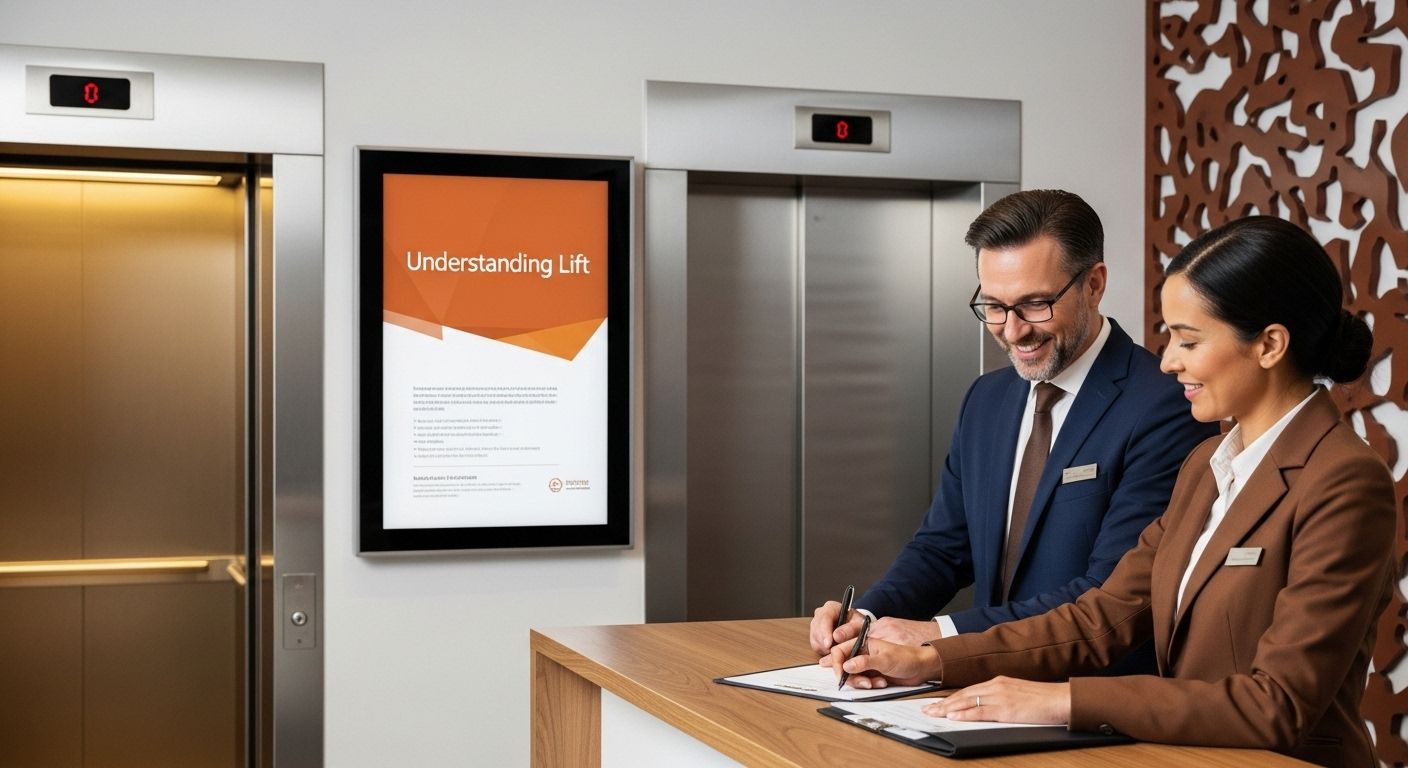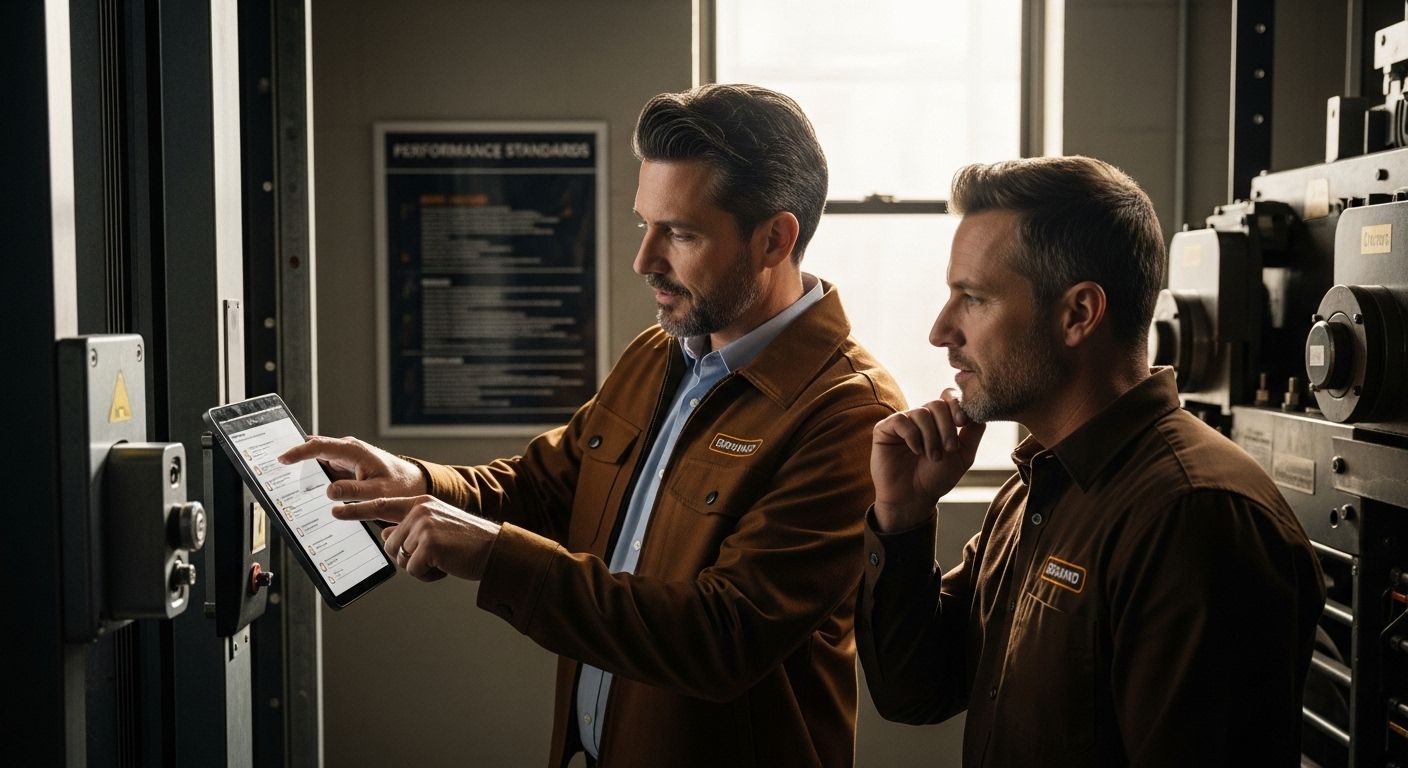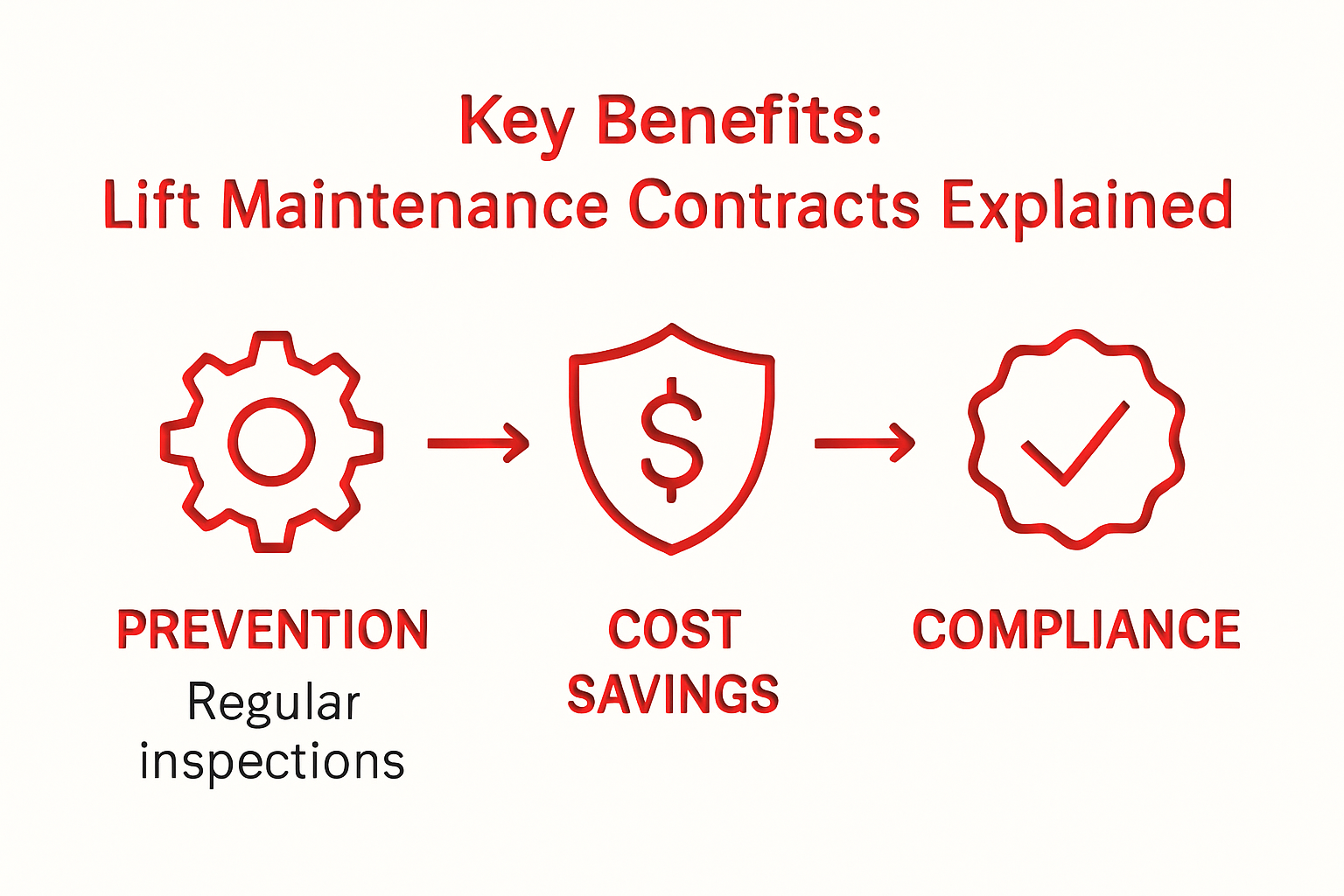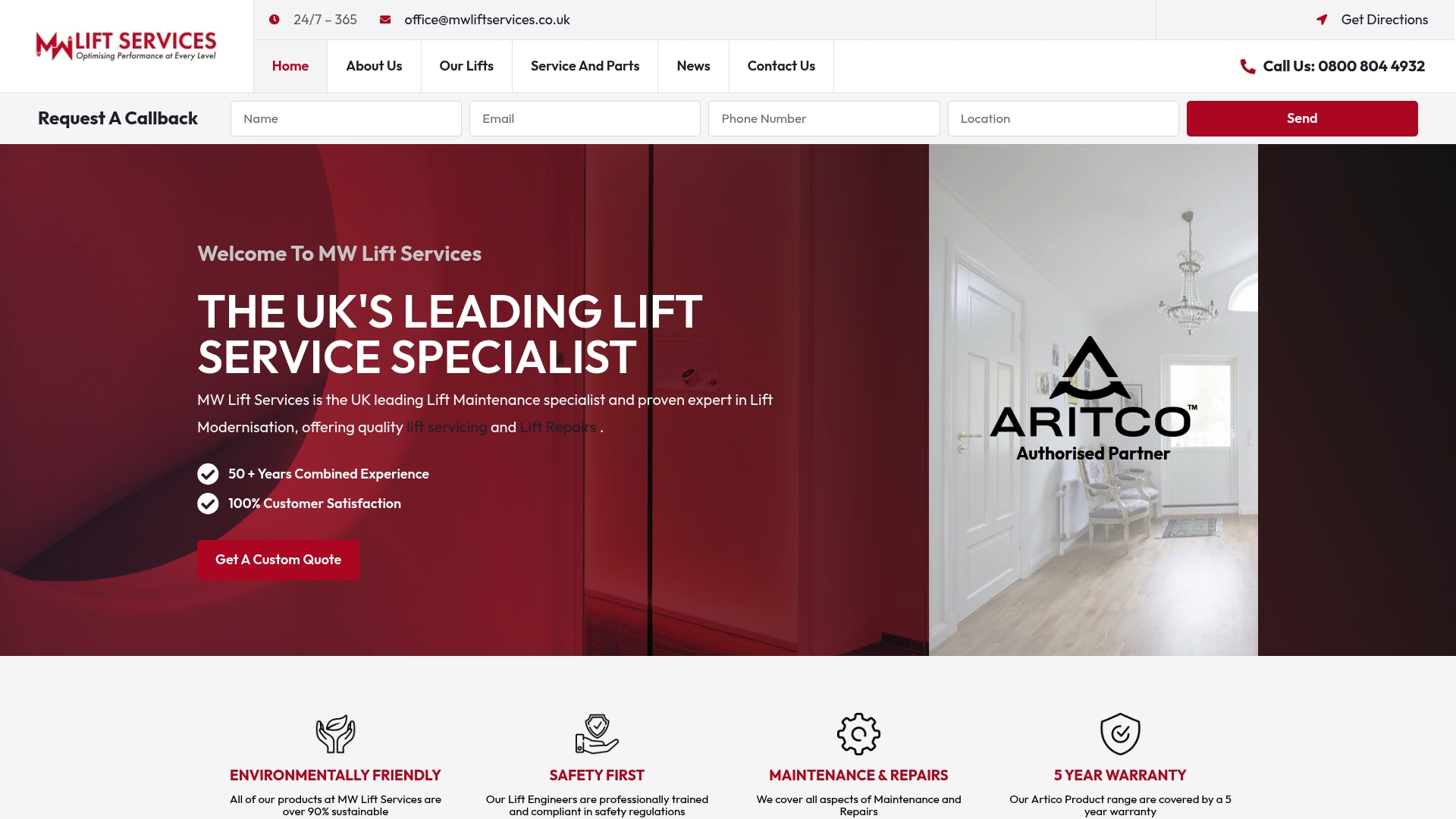Understanding Lift Maintenance Contracts Explained

Lift maintenance contracts often sound dull on paper but these agreements underpin the safety and daily function of every tall building in the UK. Surprise yourself for a moment. A single lift can carry over 20,000 people each month and that movement depends entirely on what is detailed in these contracts. The real shock is most building owners do not realise that skipping a thorough lift maintenance contract risks not just downtime but major legal and financial trouble as well.
Table of Contents
Quick Summary
| Takeaway | Explanation |
|---|---|
| Lift maintenance contracts ensure safety and compliance. | These agreements guarantee regular inspections and adherence to safety regulations for vertical transportation systems, protecting users. |
| Proactive maintenance reduces unexpected downtime. | Establishing a structured maintenance schedule helps prevent lift failures and minimises interruptions to business operations. |
| Contracts provide predictable budgeting for repairs. | By outlining service frequency and costs, lift maintenance contracts help organisations manage financial planning effectively and avoid surprise expenses. |
| Effective contracts balance performance and legal standards. | Clear performance metrics and legal provisions in maintenance agreements ensure both safety and accountability, benefiting building owners and users alike. |
| Investing in lift maintenance enhances operational reliability. | A comprehensive maintenance strategy transforms risky repair approaches into reliable, efficient management of vertical transportation systems. |
Defining Lift Maintenance Contracts: What They Are and Why They Matter
Lift maintenance contracts represent critical agreements between building owners and professional lift service providers that ensure the ongoing safety, performance, and regulatory compliance of vertical transportation systems. These comprehensive agreements go beyond simple repair services, establishing a structured approach to maintaining complex mechanical infrastructure.
The Fundamental Components of Lift Maintenance Contracts
At their core, lift maintenance contracts outline a precise framework for regular inspections, preventive maintenance, emergency repairs, and compliance management. These contracts typically include detailed specifications about service frequency, response times, and the specific scope of maintenance activities.
The table below summarises the core components commonly found in lift maintenance contracts, providing a clear overview for building owners seeking to understand what their agreements should entail.
| Component | Description |
|---|---|
| Routine Inspections | Scheduled checks to identify mechanical wear and potential issues |
| Emergency Repair Provisions | Guarantees for rapid response and repair during unexpected faults |
| Equipment Performance Assessments | Evaluation of overall lift function and system reliability |
| Regulatory Compliance Management | Ensuring continual adherence to current safety standards |
| Maintenance Frequency Specification | Detailed schedule for when services are to be performed |
| Reporting and Documentation | Records of all inspections, repairs, and maintenance performed |
Key elements often encompass:
- Regular scheduled inspections to identify potential mechanical issues
- Comprehensive equipment assessments and performance evaluations
- Prompt emergency repair provisions
- Compliance with current safety regulations and standards
According to the Occupational Safety and Health Administration, these contracts are essential for managing operational risks and ensuring user safety in vertical transportation systems.
Strategic Importance for Building Management
For building managers and owners, lift maintenance contracts represent a proactive investment in infrastructure reliability. By establishing a structured maintenance programme, organisations can significantly reduce unexpected downtime, minimise repair costs, and extend the operational lifespan of their lift systems.
The strategic benefits extend beyond immediate mechanical maintenance.
The following table offers a concise comparison of the strategic benefits that proactive lift maintenance contracts deliver to businesses, clarifying the multifaceted value beyond basic repair.
| Benefit | Operational Impact |
|---|---|
| Reduced Unexpected Downtime | Minimises business interruptions and productivity loss |
| Predictable Budgeting | Helps control maintenance costs and avoid surprise bills |
| Compliance Assurance | Demonstrates fulfilment of legal and safety obligations |
| Enhanced Asset Lifespan | Extends the useful life of lift equipment |
| Improved Performance Standards | Maintains consistent, reliable lift operation |

Ultimately, lift maintenance contracts transform reactive repair approaches into strategic, preventative management models that prioritise safety, efficiency, and long-term equipment performance.
The Importance of Lift Maintenance Contracts for Businesses
Lift maintenance contracts are far more than administrative paperwork for businesses. They represent a strategic investment in operational safety, efficiency, and long-term financial management. For organisations that rely on vertical transportation systems, these contracts provide a comprehensive approach to equipment management and risk mitigation.
Financial and Operational Risk Management
Businesses face significant financial implications when lift systems experience unexpected failures. Proactive maintenance contracts transform potential catastrophic repair scenarios into predictable, manageable operational expenses. By establishing regular inspection and service protocols, organisations can:

- Prevent costly emergency repairs
- Extend equipment operational lifespan
- Reduce unexpected downtime
- Maintain consistent performance standards
- Ensure compliance with safety regulations
According to the American Society of Mechanical Engineers, comprehensive maintenance control programmes are essential for ensuring system reliability and safety.
Safety and Legal Compliance Considerations
Beyond financial considerations, lift maintenance contracts are critical for meeting legal and regulatory requirements. Businesses have a fundamental responsibility to provide safe working environments for employees, visitors, and customers. Poorly maintained lift systems can result in significant legal liabilities, potential injury claims, and regulatory penalties.
Professional lift maintenance services help organisations navigate complex safety standards, ensuring that their vertical transportation systems meet or exceed current regulatory requirements. This proactive approach demonstrates corporate responsibility and commitment to workplace safety.
Ultimately, lift maintenance contracts represent a strategic investment that balances risk management, financial prudence, and organisational safety. By partnering with professional maintenance providers, businesses can transform potential mechanical vulnerabilities into reliable, efficient transportation infrastructure.
How Lift Maintenance Contracts Work: Key Components Explained
Lift maintenance contracts are sophisticated agreements that create a structured framework for comprehensive vertical transportation system management. These contracts go beyond simple repair services, establishing a detailed protocol for ongoing equipment care, performance monitoring, and regulatory compliance.
Structural Components of Maintenance Agreements
A comprehensive lift maintenance contract typically encompasses several critical elements that define the scope, frequency, and quality of service. Key structural components include precise specifications about:
- Frequency and depth of routine inspections
- Response time for emergency repairs
- Detailed performance benchmarks
- Replacement part provisions
- Comprehensive reporting mechanisms
According to the U.S. Department of State’s facility management guidelines, maintenance agreements must ensure that only qualified personnel perform technical interventions, adhering to manufacturer specifications and local regulatory standards.
Technical Inspection and Maintenance Protocols
The technical backbone of lift maintenance contracts revolves around systematic, regular inspections and preventative maintenance strategies. Professional technicians conduct comprehensive assessments that include:
- Mechanical system evaluations
- Electrical component diagnostics
These lift repair specialists employ advanced diagnostic tools to identify potential issues before they escalate, transforming reactive maintenance into a proactive management approach.
Ultimately, lift maintenance contracts represent a sophisticated risk management strategy. By establishing clear protocols, performance standards, and responsive service commitments, these agreements ensure vertical transportation systems remain safe, efficient, and operationally reliable.
Understanding the Terms and Conditions of Lift Maintenance Contracts
Lift maintenance contracts are intricate legal documents that define the precise relationship between service providers and building owners. These agreements establish clear expectations, responsibilities, and performance standards for vertical transportation system management, protecting both parties through comprehensive and meticulously crafted terms.
This table outlines the critical legal and operational provisions found within lift maintenance contracts, helping stakeholders quickly identify essential protections and expectations.
| Provision | Purpose |
|---|---|
| Service Scope and Frequency | Defines what services are provided and how often |
| Performance Benchmarks | Sets quality and reliability standards |
| Response Time Guarantees | Ensures prompt attention for urgent repairs |
| Pricing and Payment Schedules | Details cost structures and when payments are due |
| Liability & Indemnity Clauses | Allocates legal responsibilities and protections |
| Termination & Renewal Conditions | Explains contract starting, ending, and extension terms |
Critical Legal and Operational Provisions
Contractual terms represent the foundational framework that governs the entire maintenance relationship. These provisions typically encompass:
- Specific service scope and frequency
- Performance benchmarks and quality standards
- Response time guarantees for repairs
- Pricing structures and payment schedules
- Liability and indemnification clauses
- Termination and renewal conditions
According to the Florida Administrative Code, maintenance contracts must include detailed specifications about routine examinations and periodic safety assessments conducted by certified technicians.
Performance Metrics and Compliance Requirements
Comprehensive lift maintenance contracts integrate rigorous performance measurement mechanisms that transcend basic repair services. These metrics ensure continuous monitoring and accountability through:
- Quantifiable service level agreements
Professional lift maintenance services develop contracts that balance technical expertise with legal precision, creating transparent frameworks that protect building infrastructure and user safety.
Ultimately, understanding these terms requires careful consideration of technical capabilities, legal protections, and operational expectations. A well-constructed maintenance contract transforms a simple service agreement into a strategic partnership focused on long-term vertical transportation system reliability.
Real-World Implications: How Lift Maintenance Affects Business Operations
Lift maintenance transcends routine technical servicing, directly impacting organisational productivity, safety standards, and financial performance. For businesses operating multi-level facilities, vertical transportation systems represent critical infrastructure that can significantly influence operational efficiency and risk management.
Operational Disruption and Productivity Consequences
Unplanned lift downtime can create substantial operational challenges across various business environments. When lift systems fail unexpectedly, organisations experience:
- Reduced employee mobility
- Impaired customer accessibility
- Potential revenue interruptions
- Increased operational complexity
- Negative workplace perception
According to the National Academies Press, poorly maintained elevator systems can create significant operational inefficiencies, potentially compromising business performance and organisational reputation.
Financial and Compliance Risk Management
Comprehensive lift maintenance contracts serve as strategic risk mitigation tools. Proactive maintenance approaches help businesses:
- Predict and control maintenance expenditures
- Minimise unexpected repair costs
- Demonstrate regulatory compliance
Professional lift maintenance services provide structured frameworks that transform potential mechanical vulnerabilities into predictable, manageable operational components.
Ultimately, effective lift maintenance represents a sophisticated business strategy. By treating vertical transportation systems as critical infrastructure, organisations can protect their operational integrity, ensure user safety, and maintain continuous, efficient business performance.
Protect Your Lift Investment with Trusted Maintenance Experts
Worried about unexpected breakdowns, compliance headaches or rising costs caused by poor lift management? The article has shown how neglecting a solid lift maintenance contract can lead to real risks — from sudden repair bills to legal liabilities and business disruption. Your lifts are the heart of your building and your business deserves proactive solutions that keep everything running smoothly.

Take decisive action now. Partner with the UK’s leading specialists: MW Lift Services. Discover how our proven lift maintenance and lift repairs services give you peace of mind with structured contracts that prioritise safety and reliability. Secure your property and workforce today by choosing a service designed to fit your needs and budget. Visit mwliftservices.co.uk and make lift worries a thing of the past.
Frequently Asked Questions
What is a lift maintenance contract?
A lift maintenance contract is a formal agreement between building owners and service providers that outlines responsibilities for ongoing safety, performance, and compliance of lift systems.
Why are lift maintenance contracts important for businesses?
Lift maintenance contracts are crucial for managing operational risks, ensuring safety and compliance, and reducing unexpected repair costs, which helps maintain efficiency and budget predictability.
What key components should be included in a lift maintenance contract?
A comprehensive lift maintenance contract should include specifications on inspection frequency, service scope, response times for emergency repairs, compliance with regulations, and pricing structures.
How can lift maintenance contracts help in risk management?
These contracts help businesses by establishing proactive maintenance schedules, which can prevent unexpected failures, minimise downtime, and ensure compliance with safety regulations.







